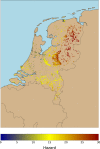Using volunteered observations to map human exposure to ticks
- PMID: 30337654
- PMCID: PMC6194133
- DOI: 10.1038/s41598-018-33900-2
Using volunteered observations to map human exposure to ticks
Abstract
Lyme borreliosis (LB) is the most prevalent tick-borne disease in Europe and its incidence has steadily increased over the last two decades. In the Netherlands alone, more than 20,000 citizens are affected by LB each year. Because of this, two Dutch citizen science projects were started to monitor tick bites. Both projects have collected nearly 50,000 geo-located tick bite reports over the period 2006-2016. The number of tick bite reports per area unit is a proxy of tick bite risk. This risk can also be modelled as the result of the interaction of hazard (e.g. tick activity) and human exposure (e.g. outdoor recreational activities). Multiple studies have focused on quantifying tick hazard. However, quantifying human exposure is a harder task. In this work, we make a first step to map human exposure to ticks by combining tick bite reports with a tick hazard model. Our results show human exposure to tick bites in all forested areas of the Netherlands. This information could facilitate the cooperation between public health specialists and forest managers to create better mitigation campaigns for tick-borne diseases, and it could also support the design of improved plans for ecosystem management.
Conflict of interest statement
The authors declare no competing interests.
Figures






References
-
- Hengeveld Geerten M., Schüll Elmar, Trubins Renats, Sallnäs Ola. Forest Landscape Development Scenarios (FoLDS)–A framework for integrating forest models, owners' behaviour and socio-economic developments. Forest Policy and Economics. 2017;85:245–255. doi: 10.1016/j.forpol.2017.03.007. - DOI
-
- Sandifer PA, Sutton-grier AE, Ward BP. Exploring connections among nature, biodiversity, ecosystem services, and human health and well-being: Opportunities to enhance health and biodiversity conservation. Ecosyst. Serv. 2015;12:1–15. doi: 10.1016/j.ecoser.2014.12.007. - DOI
MeSH terms
LinkOut - more resources
Full Text Sources
Medical

